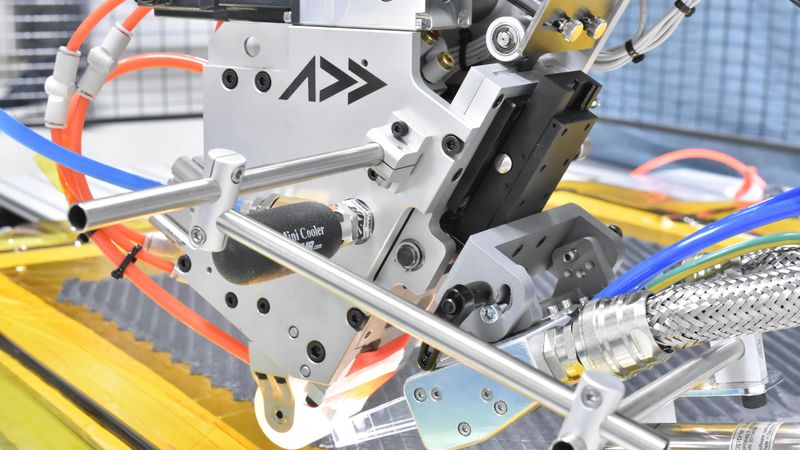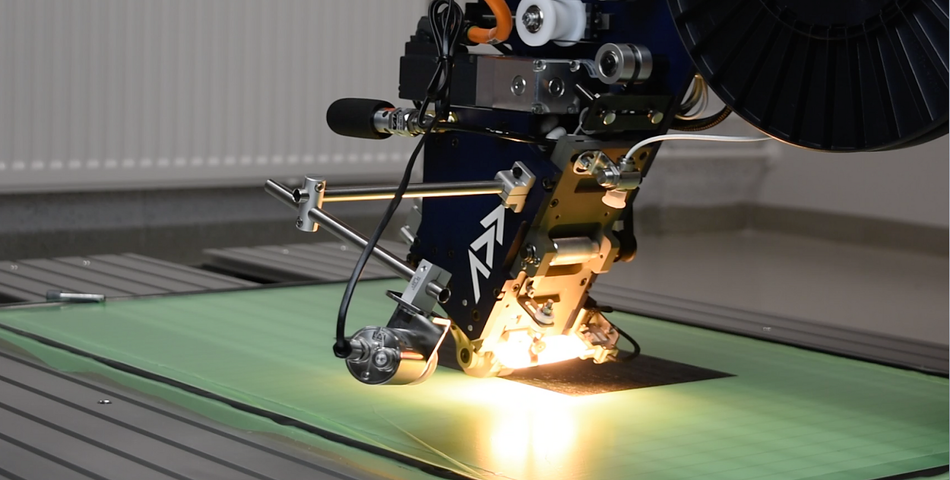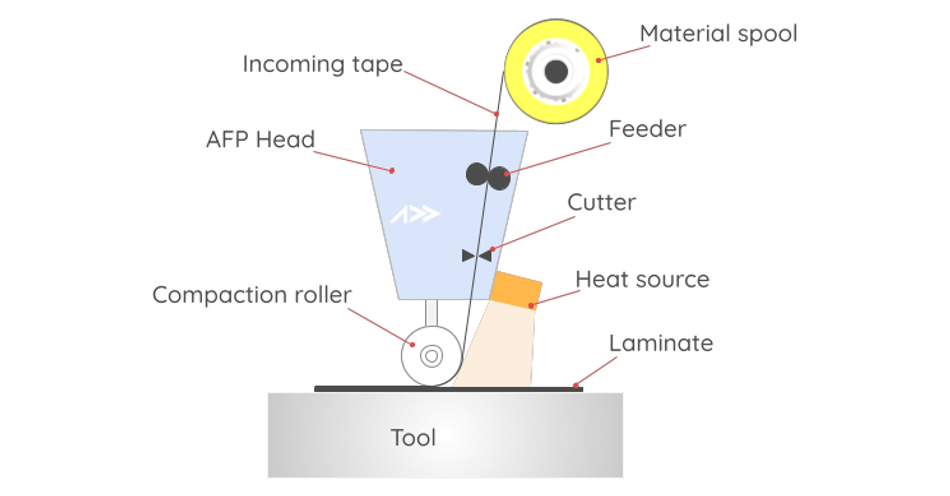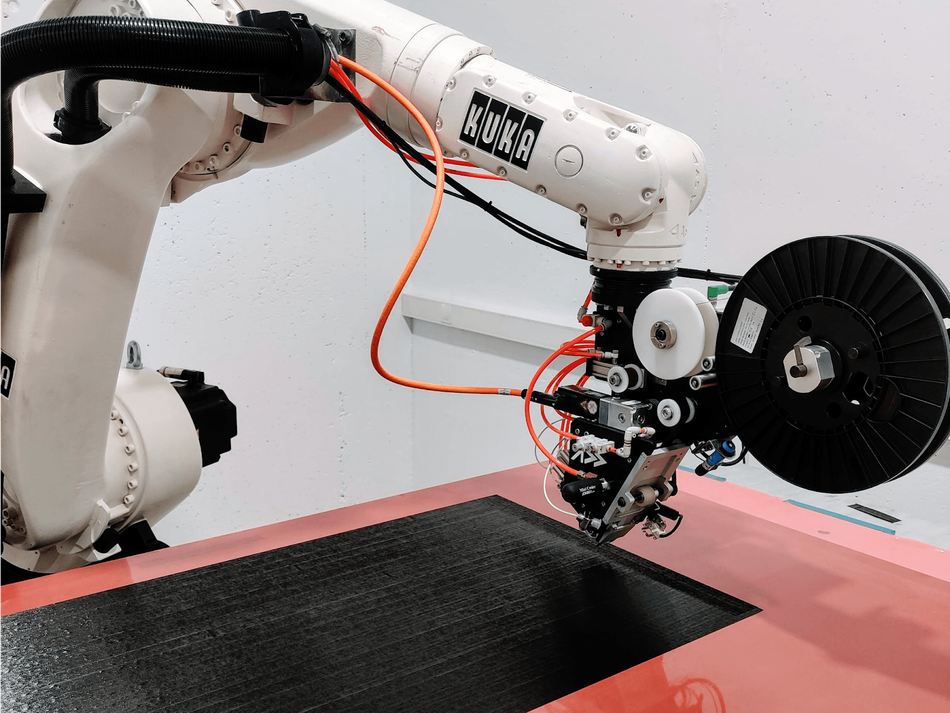What is Automated Fiber Placement (AFP) in Composites Manufacturing?
Automated Fiber Placement (AFP) is an additive manufacturing process that has three different inputs: fiber/polymer tape, heat, and pressure. This technology aims to replace manual workers in composites manufacturing with better productivity and less material waste.

Automated Fiber Placement (AFP) System with Humm3®
What is Automated Fiber Placement (AFP)?
Automated Fiber Placement (AFP) is an additive manufacturing process that has three different inputs: fiber/polymer tape, heat, and pressure. The end-effector expertly handles the tape and deposits it onto a surface with the help of heat and pressure. The process allows the fabrication of highly customized parts as each ply can be placed at different angles to best carry the required loads. The use of robotics gives the operator active control over all of the process's critical variables, making the process highly controllable and repeatable. This process can result in additively manufactured composite parts that are two times stronger than steel at one-fifth of the weight.

Figure 1. Automated Fiber Placement (AFP) System with IR Lamp
Process Fundamentals
The AFP process is essentially a mechanical-chemical bonding reaction running at the velocity of the robot's motion. The chemical process is mostly heat-activated via heaters and pressed using a compaction roller to insure low porosity.
Automated Fiber Placement Manufacturing Process
AFP systems consist of the following components:
AFP tool mounted onto a robot
Automation control system
Planning and Simulation software
AFP tool mounted onto a robot
The Automated Fiber Placement (AFP) tool head handles either one tape or multiple narrow tapes and lays them down on a predefined mold surface in a specific manner.
The material can either be mounted directly on the tool head or separate from the system entirely and then routed through various mechanisms to reach the head. Each material has its handling challenges, i.e. thermoset materials require additional cooled passage while thermoplastic tapes require a lot of heat at the endpoint of the tool.
Automation Control System
The automation control system ensures the communication between the robot and the tool, including its sensors and actuators. The AFP tool can be connected to multiple robot brands such as KUKA, ABB, Fanuc, etc., so it is very critical to ensure seamless communication with the robot. The automation system uses the fastest available protocols to communicate with the robot controller, ensuring instant signal sending/receiving.
Planning and Simulation
Over recent years there have been great advances in the optimization of AFP layups with open access to 3D Composite Manufacturing Software - AddPath. As a consequence, it is now possible to design a part and simulate its manufacturing via AFP on personal or work computers, enabling digital composites additive manufacturing from home or office with the subscriptions. You can download the AddPath directly from here and start performing simulations now.
User interaction data suggests the difficulty no longer lies with validating the concepts, but instead with figuring out how to maximize the potential of automation. Money fades whenever this equipment performs non-value-added tasks. Consequently, AFP owners want to eliminate unnecessary operations so the machines can focus on production. Through the use of advanced simulation tools, composites programmers can optimize their programs before they ever run, thus increasing up-time and freeing the system to manufacture valuable products. The key value such simulation software brings are:
Simulation to eliminate costly “dry runs”
Compiled data to improve cycle-time estimates and help with process planning.
Detect robot singularities and range of motion issues, enabling virtual modification.
Identify and avoid inconsistent heating during layup.
Pros and Cons of Automated Fiber Placement
Compared to other composite fabrication methods there are a number of key advantages and disadvantages of using AFP. These include:
Pros
Automation benefits - lower labor cost and higher production rates
Repeatable production with high traceability
High quality and accuracy of placement
Low material wastage
Monthly rental of AFP (read more)
Reinforce 3D printed parts
3D print and finish the mold, then a layup and post-process the part all with the same robot cell
Layups with Thermoset, Thermoplastics, and Dry Fiber.
Create preforms and final part shapes
Cons
Restrictions of part shape
The Future of Automated Fiber Placement (AFP)
The ongoing push for faster deposition rates, the development of new material combinations, and the increased pressure on cost reduction mean that AFP will continue to evolve in the coming years. It is expected that thermoplastics will continue to replace thermosets as the preferred polymer matrix. In addition to making better and cheaper AFP tools, they will also decrease in size, enabling a greater diversity of products to be made, and Addcomposites is at the forefront of these innovations.
The video below is the collaboration with MBDA (France) and the Compositadour team (Bayonne, France) recently demonstrated the process for manufacturing rectangular tubes with the Single-tow Automated Fiber Placement (AFP-XS) and 3D Composites Manufacturing Software (AddPath).
Addcomposites with Automated Fiber Placement (AFP) Ecosystem
Addcomposites team has been working hard to bring the latest innovations to the Automated Fiber Placement (AFP) ecosystem while achieving our mission of making composites manufacturing automation accessible. The major concern is that 65- 95% of thermoset composites manufacturing is still done by manual labor, let alone meeting the growing demand for automated thermoplastic composite manufacturing. With the growing demand for composites from various industries, the time for manufacturers to start planning for the future is now.
We rely heavily on the input from our community, which has driven the constant evolution of Automated Fiber Placement (AFP). We're listening to our end-users, and continuously improving all aspects of the system. For any questions related to composites manufacturing, please contact us through info@addcomposites.com.



